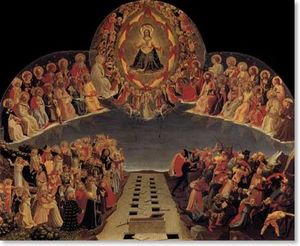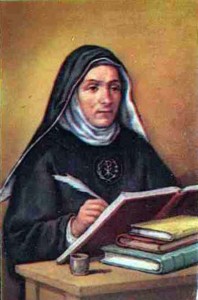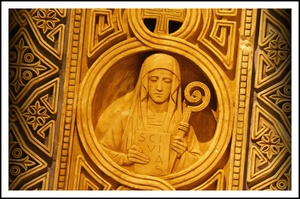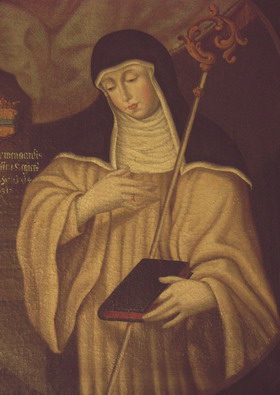The Church celebrates two Benedictine friends in several days: Saints Mechtilde and Gertrude. By today’s standards of canonizations, neither were formally canonized by the Church; until recently Hildegard enjoyed a canonization status only observed in Benedictine communities. Her liturgical observance is recognized more universally today. Pope Benedict XVI spoke eloquently of Saint Mechtilde of Hackeborn at a 2010 Wednesday Office. The Pope gives a superb insight into the person of Saint Mechtilde that is extraordinarily helpful.
Category: Benedictine saints & blesseds
Saint Gertrude the Great
Benedictine All Saints
 Today is the liturgical observance of Benedictine All Saints. Let’s pray for all those monks, nuns, sisters and oblates who lived a life of holiness and perseverance in the monastic life.
Today is the liturgical observance of Benedictine All Saints. Let’s pray for all those monks, nuns, sisters and oblates who lived a life of holiness and perseverance in the monastic life.
Blessed Maria Luisa Prosperi
 Today, the Church beatified the Venerable Servant of God Maria Luisa (nee Gertrude Prosperi; 1799-1847), a former Abbess of the Benedictine Abbey in Trevi in what is now known as the Diocese of Spoleto-Norcia (Italy). Her name is now added to the long list of Benedictine saints and blesseds.
Today, the Church beatified the Venerable Servant of God Maria Luisa (nee Gertrude Prosperi; 1799-1847), a former Abbess of the Benedictine Abbey in Trevi in what is now known as the Diocese of Spoleto-Norcia (Italy). Her name is now added to the long list of Benedictine saints and blesseds.
Cardinal Angelo Amato, SDB, Prefect of the Congregation for the Causes of Saints pronounced the papal decree of beatification. His homily may be read in Italian here.
What can we learn from Maria Luisa Prosperi?
Our new blessed was devoted to the Most Blessed Sacrament, the contemplation of the cross with a profound and exemplary love for the infinite mercy of God and the Sacred Heart of Jesus. It is Benedict XVI who tells us to recognize in Abbess Maria Luisa a singular love for the Lord’s Passion. Maria Luisa was known as a “woman in love with God.”
Blessed Maria Luisa’s liturgical memorial will be 12 September.
Blessed Maria Luisa was born on 15 August 1779 and died on 12 September 1847. She became a Benedictine nun of the Monastery of Saint Lucy in 1820 in a monastery founded in 1844.
All Saints and All Souls Days in religious orders
 The Church is not liturgically monolithic: let’s consider the various observances of feasts of All Saints and the Commemoration of the Faithful Departed (All Souls) in various religious orders:
The Church is not liturgically monolithic: let’s consider the various observances of feasts of All Saints and the Commemoration of the Faithful Departed (All Souls) in various religious orders:
- November 5: the Society of Jesus
- November 7: the Order of Preachers
- November 13: the Order of St Benedict; Order of St Augustine; the Trinitarian Order
- November 29: the Franciscan Families
- October 5: the Capuchin Order
- November 5: the Franciscan Families
- November 8: the Order of Preachers
- November 13: the Carthusians
- November 14: the Order of St Benedict; the Trinitarian Order
- November 15: the Order of Carmel
- November 16: the Servite Order
Saint Hildegard of Bingen
 O Lord, you were generous with your gifts of grace to the virgin Hildegard. By following closely her example and teaching, may we pass from the darkness of this life into your marvelous light.
O Lord, you were generous with your gifts of grace to the virgin Hildegard. By following closely her example and teaching, may we pass from the darkness of this life into your marvelous light.
Saint Hildegard (1098-1179) was a Benedictine of great learning ( a true polymath), a holy woman who was known for her visions, prophesies, poetry and spiritual guidance. Some have likened her to Dante and William Blake. She was given the title of the Sibyl of the Rhine. Since the 15th century Hildegard’s name was in the Roman Martyrology but was not officially canonized. On May 10, 2012 Pope Benedict XVI gave the entire Church the liturgical memory of Saint Hildegard (the equivalent of canonizing her); the Pope stated that on October 7, 2012 he will name the Saint a Doctor of the Church.
We pray for the Benedictine Congress in Rome that begins today and goes until the 25th through the intercession of Saint Hildegard.
Saint Gregory the Great
 Blessed Gregory, raised upon the throne of Peter, sought always the beauty of the Lord and lived in celebration of that love.
Blessed Gregory, raised upon the throne of Peter, sought always the beauty of the Lord and lived in celebration of that love.
Blessed Ildefonso Schuster
Today we honor the Church honors a great 20th century Benedictine monk, priest, bishop and cardinal, Blessed Alfredo Ildefonso Schuster. He died on this date in 1954. At the time of his death he was the cardinal-archbishop of Milan.
Saint Bernard Tolomei
-thumb-285x351-12511.jpg) An obscure Benedictine saint is liturgically honored by the Church today. Saint Bernard Tolomei, (1272-1348) the founder of the Benedictine Congregation of the Blessed Virgin of Monte Oliveto (near Siena) in 1319. He was beatified in 1644 but not canonized until 2009, though he was revered as a saint for a long time before Pope Benedict canonized him.
An obscure Benedictine saint is liturgically honored by the Church today. Saint Bernard Tolomei, (1272-1348) the founder of the Benedictine Congregation of the Blessed Virgin of Monte Oliveto (near Siena) in 1319. He was beatified in 1644 but not canonized until 2009, though he was revered as a saint for a long time before Pope Benedict canonized him.
Saint Bernard, 900 years since entering Cîteaux
Nearly 900 years ago Bernard of Fontaine-lès-Dijon led
a group of young Burgundian noblemen, to the Abbey of Cîteaux in 1112 or 1113. The fledgling
new monastery got a burst of new life and from there set the world ablaze with
what became the Cistercian charism.
North America, paying particular attention to the intention of young men and women entering the
monastic life under the gaze of Saint Bernard. Beginning today until a year from now, the Cistercians are observing a Year of Saint Bernard. Let’s join them in knowing more about this pivotal saint and monk.
the New Monastery at Cîteaux our fathers followed the poor Christ into the
desert. Thus they lived the Gospel, by rediscovering the Rule of Saint Benedict
in its purity.
attractive and appealing to others, in the joy of the Holy Spirit.
we today, after their example, may live our charism deeply in a spirit of
peace, unity, humility, and above all, in the charity which surpasses all other
gifts.
life, in the service of the Church’s mission, in a world often forgetful of
You.
enthusiastic and generative spirit of the founders. And in all of our needs may
we always turn to Our Lady whom Bernard called the Star of the Sea.
Father, from whom we have already received so much, grant us again your
blessing that our communities may grow in numbers, but above all in grace and
in wisdom, to your glory, who are blessed for ever and ever. Amen.





